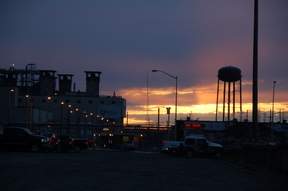On the surface, it was an unseasonably warm and brilliant orange early autumn day. Underground, it was closing time. Not last call, but rather the hard rock mining on-the-job equivalent: last hoist.
This day has almost come for Birchtree Mine in Thompson, Manitoba before. In fact, the day did come for Birchtree for most of a decade in the 1980s, as the mine was on “care and maintenance” because of unfavourable market conditions from December 1977 through 1989.
And on Oct. 18, 2012, Vale had announced care and maintenance was being considered for Birchtree Mine in 10 months time in August 2013. After finding $100 million in cost savings at its Manitoba Operations, bringing its cost per metric tonne for finished nickel to under US$10,000, Birchtree Mine would receive on May 6, 2013 a reprieve that lasted almost 4½ years. Until now.
As well as nickel, Birchtree has deposits of copper, cobalt, gold, silver, platinum and palladium. Re-opening of Birchtree was considered in 1981, but was deferred in favour of development of the Thompson open pit mine. Care and maintenance is a term used in the mining industry to describe processes and conditions on a closed minesite where there is potential to recommence operations at a later date. During a care and maintenance phase, production is stopped but the site is managed to ensure it remains in a safe and stable condition.
Preparation to place Birchtree on care and maintenance again some 28 years after its last mining production 12-year hiatus begins two days hence on Monday. Asset recovery is expected to be complete by mid-November, and the plan is for the mine to be officially on care and maintenance by Dec. 31. The current life of mine plan has long anticipated the closure of Birchtree Mine at some point around now. Vale, however, could, as was the case with Inco in 1989, reopen Birchtree Mine should nickel prices rebound more strongly than forecast in the next few years, and the company has said it believes there is a future for the mine.
The current London Metal Exchange (LME) price of nickel per pound would likely have to at least double from US$4.72 to make reopening Birchtree for a second time economically viable. While Thompson is noted for its high quality 99.9 per cent pure electrolytic nickel that is almost free of contaminants such as lead or zinc, resulting in it often commanding a higher price than the LME price, Birchtree has relatively lower nickel grades. Nickel prices peaked at $25.51 per pound on the LME in May 2007, just months after Vale, the Brazilian mining giant, bought Inco in a $19.9-billion all-cash tender takeover offer deal in October 2006. Nickel prices have fallen nearly 70 per cent in the past six years as international supply far outstrips demand.
The nickel find near Manasan Falls, four kilometres east of Birchtree Lake and about five kilometres southwest of Thompson, that would become Birchtree Mine was first announced publicly to the world on April 22, 1964 by Henry S. Wingate, chairman of the board of the International Nickel Company of Canada (INCO) Limited.
There are several other key dates in Thompson’s early mining history: Borehole 11962 – the so-called “Discovery Hole” at Cook Lake, a diamond drill exploration hole – was collared Feb. 5, 1956 and assayed positive for nickel.
There’s also the Dec. 3, 1956 signing of the founding 33-page typewritten double-spaced agreement creating Thompson between the Province of Manitoba’s F.C. Bell, minister of mines and natural resources, and International Nickel Company of Canada Limited’s Ralph Parker, vice-president and general manager, and secretary William F. Kennedy. As well, there was Manitoba Liberal-Progressive Premier Douglas Campbell driving the last spike in the Canadian National Railway (CNR) 30-mile branch line from Sipiwesk to Thompson Oct. 20, 1957, and March 25, 1961, when Progressive Conservative Premier Duff Roblin cut the nickel ribbon to officially open the $185-million smelter and refinery, set to close also next August, as the world’s first fully integrated nickel operation, and with its 1,800 employees, second in size in the “free world” at the time only to Inco’s Sudbury operations. Vale’s Thompson operations, landholdings or mining rights, consist of at least 2,947 order-in-council (OIC) leases, mineral leases and mining claims “negotiated as part of an agreement entered into in 1956 between Vale Inco and the Province of Manitoba covering the development of the Thompson nickel deposits,” noted filings by the company in 2004 and 2008 with the U.S. Securities and Exchange Commission.
Thompson, originally a townsite within the newly-created 975-square-mile Local Government District (LGD) of Mystery Lake, within the Dauphin Judicial District, from 1956 to 1966, became a town on Jan. 3, 1967 and a city just 3½ years later on July 7, 1970.
Wingate, a lawyer, was born in Talas, Turkey, the son and grandson of American missionaries, and was raised in Northfield, Minnesota. He was with the New York law firm of Sullivan & Cromwell from 1929 to 1935, when he joined INCO as assistant secretary. The sinking of the Birchtree Mine development shaft began on Ink 6 in 1964. The three-compartment shaft was completed to 1,373 feet a year later.
Birchtree began production in 1966. Between 1965 and 1967 the production shaft on Pip 301 was sunk to 2,800 feet, with levels between 300 and 2,300 feet at 200-foot intervals. Inco announced plans in 2000 to move ahead with a $70.4-million deepening of Birchtree Mine to be completed in 2002 and help extend the mine’s life by at least 15 years. In its Exploration and Development Highlights 2001 report, the Manitoba Science, Technology, Energy and Mines Department estimated the shaft deepening would access proven reserves of 13.6 million tonnes of 1.79 per cent nickel and “extend Birchtree’s production to 2016.”
As a result of the Birchtree Mine closing, about 200 high-paid jobs are expected to disappear from the local economy over the next few months – a very big though by no means fatal hit to the local economy – including not only Vale employees but other mining sector contractors and support service positions.
You can also follow me on Twitter at: https://twitter.com/jwbarker22








